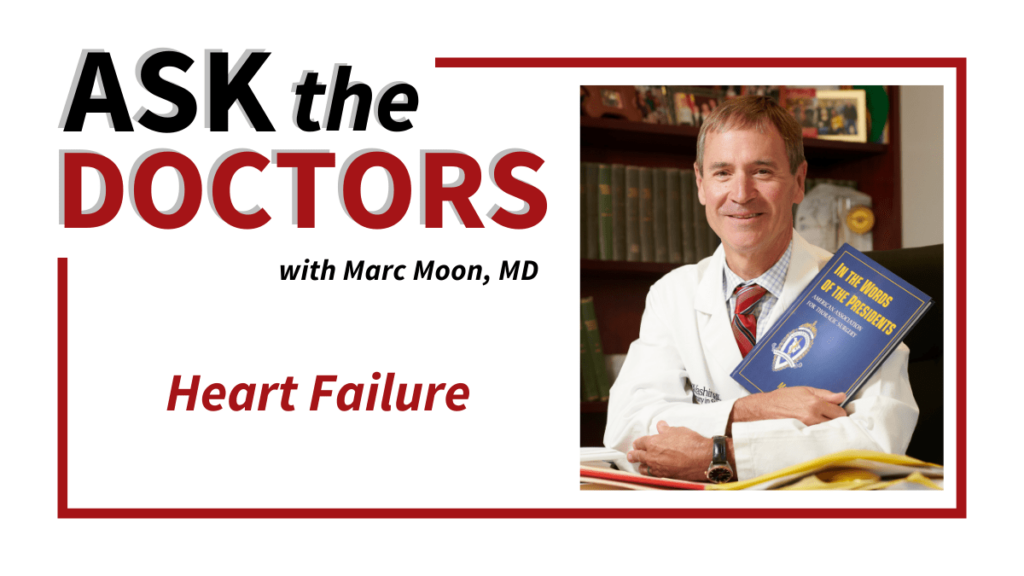The heart is an essential organ responsible for distributing blood, nutrients and oxygen throughout the body. Heart failure (HF) is a progressive condition in which the muscle tissue of the heart no longer pumps the necessary amount of blood into the circulatory system, causing symptoms like fatigue and shortness of breath before progressing into other health complications. Multiple types of HF are diagnosed and treated by physicians. Dr. Marc Moon, MD, Chief of Cardiac Surgery at the Washington University School of Medicine in St. Louis, explains the variations, stages and causes of heart failure as well as how it is treated or managed throughout the patient’s life.
What is heart failure? Is it the same as congestive heart failure?
Heart failure (HF) is a chronic and progressive condition in which the muscle tissue of the heart cannot pump enough blood to supply oxygen and circulation throughout the body. The term “heart failure” actually means the heart is not pumping sufficiently, not that it has ceased function. Congestive heart failure is a type of heart failure requiring immediate medical attention, but these terms are often used interchangeably.
The body depends on its heart’s pumping action to deliver oxygen- and nutrient-rich blood to tissues and cells throughout. When these needs are not met, as in HF, symptoms such as fatigue and shortness of breath can manifest. Everyday activities can become difficult, and other health complications may arise if the condition progresses.
What is ejection fraction?
Ejection fraction (EF) is how well your heart ventricle (left or right ventricle) pumps blood per heartbeat. EF usually refers to the amount of blood pumped out of the left ventricle each time it contracts, as the left ventricle is the heart’s main pumping chamber.
EF is expressed as a percentage of 0-100%. an EF below the normal range of 50-75% can be a sign of heart failure. If a patient has heart failure and a reduced EF, a condition also referred to as HF-rEF, the patient’s precise EF reading helps their doctor know how severe the condition is.
What are right side and left side heart failure? What are diastolic and systolic heart failure?
HF can involve the left side, right side or both sides of the heart, though it usually affects the left side first.
Left-sided heart failure
After the left atrium receives blood from the lungs, the left ventricle sends oxygen-rich blood to the rest of the body. The left ventricle is also larger than the other chambers because it supplies most of the heart’s pumping power. In left-sided or left ventricular (LV) heart failure, this part of the heart works harder to pump the same amount of blood. Two types of left-sided heart failure exist:
Heart failure with reduced ejection fraction (HFrEF), also called systolic failure: The left ventricle cannot contract normally, so the heart can’t pump with the force necessary to circulate enough blood.
Heart failure with preserved ejection fraction (HFpEF), also called diastolic failure (or diastolic dysfunction): The left ventricle cannot relax normally due to the muscle becoming stiff, so the heart can’t fill with blood during the resting period between heartbeats.
Right-sided heart failure
“Used” blood reenters the heart from the body through the right atrium. The right ventricle then pumps oxygen- and nutrient-lacking blood out of the heart and to the lungs to be replenished.
Right-sided or right ventricular (RV) heart failure usually occurs after left-sided failure. When the left ventricle fails, increased fluid pressure moves back through the lungs and damages the heart’s right side. As a result of right side damage, blood backs up in the body’s veins and leads to swelling or congestion in the lower body and abdomen.

How does heart failure progress? Does it cause complications?
The heart responds to decreased function of HF in a few key ways that impact the process of circulation. The heart stretches and eventually enlarges to contract more strongly and keep up with circulatory demands. Heart muscle mass increases as the contracting cells enlarge, and the speed of contractions increases.
The circulatory system tries to compensate for these changes, as well. Blood vessels will narrow to promote blood pressure and make up for the heart’s loss of power. Blood is diverted from less important tissues and organs before being restricted from the heart and brain.
While these changes mask the problem of HF, they don’t solve it. HF progresses until these compensations fail to promote regular circulation. Complications will also develop depending on the severity of HF. Kidney damage or failure, heart valve problems, and liver failure can result from the reduction of blood flow.
When heart failure is diagnosed, how does the doctor classify it?
There are two parts to a formal HF diagnosis: the patient symptom and functionality and the stage of damage in the heart. Patient testimony is necessary to gauge the impact HF has on their daily activity, and a physician’s assessment of their heart muscle indicates to what level the HF has progressed.
Patient Symptoms
- Class I: No limitation to physical activity, and ordinary physical activity does not cause undue fatigue, palpitation or shortness of breath.
- Class II: Minor limitations to physical activity, but patient is comfortable at rest. Ordinary physical activity causes fatigue, palpitation or shortness of breath.
- Class III: Notable limitation to physical activity, but patient is still comfortable at rest. Even limited activity causes fatigue, palpitation or shortness of breath.
- Class IV: Patient is unable to engage in any physical activity without discomfort, and symptoms are experienced at rest.
Diagnosed Stage
- Class A: No objective evidence of cardiovascular disease, symptoms or limitation to ordinary physical activity.
- Class B: Evidence of minimal cardiovascular disease, mild symptoms and slight limitation to ordinary activity.
- Class C: Evidence of moderate cardiovascular disease, moderate symptoms and notable limitation in all activity due to symptoms, even during less-than-ordinary activity.
- Class D: Evidence of severe cardiovascular disease, limitations and symptoms even while at rest.
What are the signs and symptoms of heart failure? Do they differ between people?
Early stages of HF may have symptoms of dry cough, new or worsening shortness of breath during exercise, new or increased swelling in the lower body and abdomen, sudden weight gain over three pounds and trouble sleeping. Later stages that indicate the need for immediate medical treatment include frequent coughing, shortness of breath while resting, fluid buildup, increasing swelling and discomfort in the lower body, dizziness, confusion and loss of appetite. Other common symptoms include fatigue, irregular heartbeat, mucus in cough, nausea and chest pain. It is paramount a patient see a doctor if they experience any of these signs.
Biologically female people have different experiences with HF than biologically male people, although the likelihood of developing HF is equal. Development is usually later in life and more likely caused by high blood pressure with a normal ejection fraction. Biologically female people also more often experience shortness of breath as a symptom.
The body’s compensation to HF (i.e. the enlargement of the heart) explain why some people may not become aware of their condition until years after heart failure begins, so it is important to consult a doctor when even mild symptoms appear and remain consistent.
What are the causes of heart failure? Are there risk factors for developing heart failure?
Most people who develop HF have another heart condition first, causing damage or weakening of the heart. The most common conditions that can lead to heart failure are coronary artery disease, high blood pressure, dysfunctional heart valves, myocarditis, arrythmia and previous heart attack. Congenital heart defects and long-term diseases like diabetes may also contribute to heart failure. If you’ve been diagnosed with one of these conditions, it’s critical that you manage it carefully to help prevent the onset of heart failure.
Acute heart failure occurs when a sudden condition leads to heart damage and poor heart function. Some causes include allergic reactions, blood clots in the lungs, severe infection and viruses that attack heart muscle.
HF is more likely to happen as you age, smoke, drink or have a high level of body fat, but anyone can develop heart failure. Still, if you have heart failure, you can live a full and active life with the right medical treatment and lifestyle.
What treatments are available for heart failure?
Treatment for HF is variable, dependent on the type and stage of heart failure. Physicians consult with patients to determine their best options. A treatment plan may include:
- Lifestyle changes, including increasing activity, quitting smoking, tracking fluid intake, limiting alcohol and caffeine, healthy diet and monitoring blood pressure
- Medications
- Devices
- Implantable cardioverter defibrillator, a heart rhythm regulator
- Cardiac resynchronization therapy, a pacemaker-type device
- Left ventricle assist device, an implanted pumping device
- Surgical procedures
- Heart transplantation or replacement
- Percutaneous coronary intervention, or angioplasty, to remove blockages
- Coronary artery bypass to reroute blood supply
- Valve replacement to improve blood flow regulation
- Ongoing care, including reporting any changing symptoms to doctors

How long can you live with congestive heart failure? Is it curable?
Heart failure is a serious medical condition, and it is not often cured, but many people with HF lead a full life with the guided management of a physician. Medication and lifestyle changes as well as surgical procedures can extend lifespan. It’s also essential to have a support network of people who understand the condition and any limitations it causes.
Over 6 million Americans are living with HF, and over 900,000 new cases are diagnosed annually. Patients can manage this condition and should seek medical advice to do so.
Washington University Heart Failure Treatment
Washington University School of Medicine treats patients with all stages of heart failure, and the Department of Surgery provides our patients with physicians and treatments specific to the patient’s needs. Contact our Division of Cardiothoracic Surgery to learn more about diagnosis and treatment of this condition.

